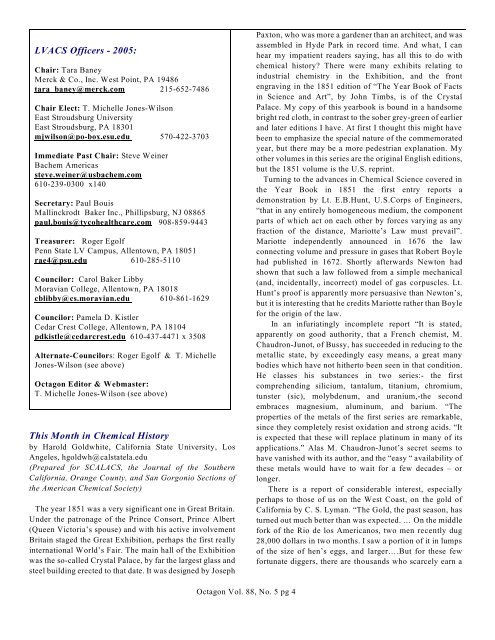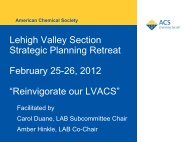the octagon - Lehigh Valley Section of the American Chemical Society
the octagon - Lehigh Valley Section of the American Chemical Society
the octagon - Lehigh Valley Section of the American Chemical Society
You also want an ePaper? Increase the reach of your titles
YUMPU automatically turns print PDFs into web optimized ePapers that Google loves.
LVACS Officers - 2005:<br />
Chair: Tara Baney<br />
Merck & Co., Inc. West Point, PA 19486<br />
tara_baney@merck.com 215-652-7486<br />
Chair Elect: T. Michelle Jones-Wilson<br />
East Stroudsburg University<br />
East Stroudsburg, PA 18301<br />
mjwilson@po-box.esu.edu 570-422-3703<br />
Immediate Past Chair: Steve Weiner<br />
Bachem Americas<br />
steve.weiner@usbachem.com<br />
610-239-0300 x140<br />
Secretary: Paul Bouis<br />
Mallinckrodt Baker Inc., Phillipsburg, NJ 08865<br />
paul.bouis@tycohealthcare.com 908-859-9443<br />
Treasurer: Roger Egolf<br />
Penn State LV Campus, Allentown, PA 18051<br />
rae4@psu.edu 610-285-5110<br />
Councilor: Carol Baker Libby<br />
Moravian College, Allentown, PA 18018<br />
cblibby@cs.moravian.edu 610-861-1629<br />
Councilor: Pamela D. Kistler<br />
Cedar Crest College, Allentown, PA 18104<br />
pdkistle@cedarcrest.edu 610-437-4471 x 3508<br />
Alternate-Councilors: Roger Egolf & T. Michelle<br />
Jones-Wilson (see above)<br />
Octagon Editor & Webmaster:<br />
T. Michelle Jones-Wilson (see above)<br />
This Month in <strong>Chemical</strong> History<br />
by Harold Goldwhite, California State University, Los<br />
Angeles, hgoldwh@calstatela.edu<br />
(Prepared for SCALACS, <strong>the</strong> Journal <strong>of</strong> <strong>the</strong> Sou<strong>the</strong>rn<br />
California, Orange County, and San Gorgonio <strong>Section</strong>s <strong>of</strong><br />
<strong>the</strong> <strong>American</strong> <strong>Chemical</strong> <strong>Society</strong>)<br />
The year 1851 was a very significant one in Great Britain.<br />
Under <strong>the</strong> patronage <strong>of</strong> <strong>the</strong> Prince Consort, Prince Albert<br />
(Queen Victoria’s spouse) and with his active involvement<br />
Britain staged <strong>the</strong> Great Exhibition, perhaps <strong>the</strong> first really<br />
international World’s Fair. The main hall <strong>of</strong> <strong>the</strong> Exhibition<br />
was <strong>the</strong> so-called Crystal Palace, by far <strong>the</strong> largest glass and<br />
steel building erected to that date. It was designed by Joseph<br />
Octagon Vol. 88, No. 5 pg 4<br />
Paxton, who was more a gardener than an architect, and was<br />
assembled in Hyde Park in record time. And what, I can<br />
hear my impatient readers saying, has all this to do with<br />
chemical history? There were many exhibits relating to<br />
industrial chemistry in <strong>the</strong> Exhibition, and <strong>the</strong> front<br />
engraving in <strong>the</strong> 1851 edition <strong>of</strong> “The Year Book <strong>of</strong> Facts<br />
in Science and Art”, by John Timbs, is <strong>of</strong> <strong>the</strong> Crystal<br />
Palace. My copy <strong>of</strong> this yearbook is bound in a handsome<br />
bright red cloth, in contrast to <strong>the</strong> sober grey-green <strong>of</strong> earlier<br />
and later editions I have. At first I thought this might have<br />
been to emphasize <strong>the</strong> special nature <strong>of</strong> <strong>the</strong> commemorated<br />
year, but <strong>the</strong>re may be a more pedestrian explanation. My<br />
o<strong>the</strong>r volumes in this series are <strong>the</strong> original English editions,<br />
but <strong>the</strong> 1851 volume is <strong>the</strong> U.S. reprint.<br />
Turning to <strong>the</strong> advances in <strong>Chemical</strong> Science covered in<br />
<strong>the</strong> Year Book in 1851 <strong>the</strong> first entry reports a<br />
demonstration by Lt. E.B.Hunt, U.S.Corps <strong>of</strong> Engineers,<br />
“that in any entirely homogeneous medium, <strong>the</strong> component<br />
parts <strong>of</strong> which act on each o<strong>the</strong>r by forces varying as any<br />
fraction <strong>of</strong> <strong>the</strong> distance, Mariotte’s Law must prevail”.<br />
Mariotte independently announced in 1676 <strong>the</strong> law<br />
connecting volume and pressure in gases that Robert Boyle<br />
had published in 1672. Shortly afterwards Newton had<br />
shown that such a law followed from a simple mechanical<br />
(and, incidentally, incorrect) model <strong>of</strong> gas corpuscles. Lt.<br />
Hunt’s pro<strong>of</strong> is apparently more persuasive than Newton’s,<br />
but it is interesting that he credits Mariotte ra<strong>the</strong>r than Boyle<br />
for <strong>the</strong> origin <strong>of</strong> <strong>the</strong> law.<br />
In an infuriatingly incomplete report “It is stated,<br />
apparently on good authority, that a French chemist, M.<br />
Chaudron-Junot, <strong>of</strong> Bussy, has succeeded in reducing to <strong>the</strong><br />
metallic state, by exceedingly easy means, a great many<br />
bodies which have not hi<strong>the</strong>rto been seen in that condition.<br />
He classes his substances in two series:- <strong>the</strong> first<br />
comprehending silicium, tantalum, titanium, chromium,<br />
tunster (sic), molybdenum, and uranium,-<strong>the</strong> second<br />
embraces magnesium, aluminum, and barium. “The<br />
properties <strong>of</strong> <strong>the</strong> metals <strong>of</strong> <strong>the</strong> first series are remarkable,<br />
since <strong>the</strong>y completely resist oxidation and strong acids. “It<br />
is expected that <strong>the</strong>se will replace platinum in many <strong>of</strong> its<br />
applications.” Alas M. Chaudron-Junot’s secret seems to<br />
have vanished with its author, and <strong>the</strong> “easy “ availability <strong>of</strong><br />
<strong>the</strong>se metals would have to wait for a few decades – or<br />
longer.<br />
There is a report <strong>of</strong> considerable interest, especially<br />
perhaps to those <strong>of</strong> us on <strong>the</strong> West Coast, on <strong>the</strong> gold <strong>of</strong><br />
California by C. S. Lyman. “The Gold, <strong>the</strong> past season, has<br />
turned out much better than was expected. … On <strong>the</strong> middle<br />
fork <strong>of</strong> <strong>the</strong> Rio de los <strong>American</strong>os, two men recently dug<br />
28,000 dollars in two months. I saw a portion <strong>of</strong> it in lumps<br />
<strong>of</strong> <strong>the</strong> size <strong>of</strong> hen’s eggs, and larger….But for <strong>the</strong>se few<br />
fortunate diggers, <strong>the</strong>re are thousands who scarcely earn a



